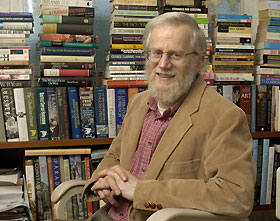Historian Tracks Trends In
Attitudes Toward Death Penalty
 |
| Lawrence Goodheart, a professor of history at the Greater Hartford campus, is writing a history of capital punishment in Connecticut. |
Photo by Peter Morenus |
Lawrence Goodheart has focused his scholarship on what might be considered unsavory topics: slavery, madness, murder.
“When you look at a society through extreme issues, you can see just what it’s really made of. And you can see its contradictions,” says Goodheart, a professor of history at the Greater Hartford campus.
The “extreme issue” of his current work may be his grimmest subject to date: capital punishment. His historical survey, drawing upon the state’s wealth of early records and documents, will culminate in a book called “The Death Penalty in Connecticut, 1636-2005.” The book will not only analyze who was executed for what crime, but also pose such provocative questions as: What does it say about late-18th and early 19th century society in Connecticut that several black men were executed for the rape of white women, while no white men received the death penalty for that crime? And what is revealed about present-day society when, after 45 years without an execution in the state, serial killer Michael Ross will be put to death by lethal injection?
Goodheart’s research examines how and why cultural sensibilities and historical events have mingled to shape attitudes toward and implementation of the death penalty. He points out that in some ways, much has changed in nearly 400 years of Connecticut history. For example, newspaper accounts from the 1700’s describe public hangings as having fair-like atmospheres, with booths of refreshments for the crowds in attendance. This stands in contrast to the circumstances of Michael Ross’s execution, set to take place behind closed doors in the dead of night.
On the other hand, Goodheart finds certain “continuities” and patterns that repeat over time. Although today’s debate over capital punishment was generated in part by scientific advances such as DNA testing – and the consequent exoneration of many Death Row inmates – the current campaign to abolish the death penalty is, he says, simply the latest of several attempts in Connecticut history, the most recent of which took place in the 1950’s.
Goodheart also finds that throughout history the pendulum of public sentiment swings back and forth from a fatalistic view about punishing evildoers to a more optimistic view that allows for the rehabilitation of criminals. Thus, in 1740, a Windham man convicted of burglary three times was viewed as “incorrigible” and duly hanged. Decades later, ideals associated with the Enlightenment would lead to the development of prisons as more humane and rehabilitative alternatives to capital punishment.
While tracking these general trends, the research also examines the specifics of 160 executions. Goodheart, who has received funding for his work from the University’s Human Rights Institute, believes that when the death penalty is applied more often to people of color and immigrants, it is indicative of which groups appeared to be threatening to the white population at any given time. For example, in addition to that cluster of black men executed for raping white women, Goodheart has found that from about 1880 to 1940 – a time of increasing urbanization, industrialization, and immigration – an inordinate number of Italian Americans or Italian immigrants were executed in Connecticut.
Overall, though, what has surprised Goodheart most is Nutmeggers’ historical inclination toward restraint. Procedures, protocols, and high evidentiary standards have more often than not overruled emotions. “You can see this in the witchcraft trials in the 1600’s in Hartford,” says Goodheart. “There are a handful of people, mostly women, who are publicly hanged for being witches. But what’s surprising to me is that there weren’t more people hanged – because there were about 30 people who came before the courts with accusations of witchcraft.”
He notes that in the neighboring state of Massachusetts, Salem’s witch trials claimed about 20 lives. Looking at Connecticut’s history, he says, “I have been impressed with what you would call the rule of law.”
And in the end, in nearly 400 years of Connecticut history, the state has executed only about 165 individuals. Goodheart notes that in comparison, the state of Texas executed some 150 people just in the six years of George W. Bush’s tenure as governor. Goodheart likes to use that comparison not to make a partisan jab at the president but rather to draw attention to what he sees as a national trend toward conservatism.
He says that in the post-9/11 world of fear and fatalism, Michael Ross, a confessed rapist and murderer, seems to be a local embodiment of evil. However, although Ross’s guilt is certain, the important question for Goodheart is whether or not Ross’s execution will pave the way for a new wave of executions in Connecticut, ones that may unjustly target those on the lowest rungs of the social ladder.
History, he notes, can’t provide the answer as to what will or should happen to Michael Ross, who has the right to appeal up until the moment of his execution, but it can give today’s society some perspective on how and why the death penalty is meted out.
“It is the job of an enlightened citizenry,” says Goodheart, to examine such questions in order to “better shape the present and create a better future.”

